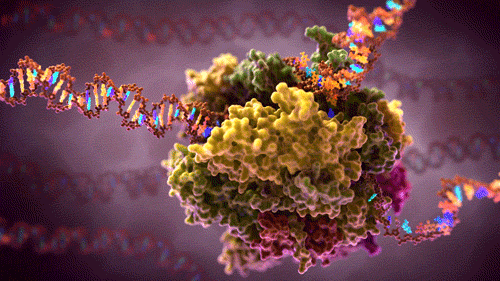
Artist's conception of an RNA polymerase (globular molecule) creating strands of RNA (exiting the polymerase on the right) from a DNA template (entering the polymerase on the left). Known as RNA transcription, the process is the first step in gene expression, the carrying out of biological functions as directed by DNA. Researchers studying gene expression can use a new NIST software tool to evaluate the performance of their experimental methods and be confident that the results are valid.
A new, innovative "dashboard" from the National Institute of Standards and Technology (NIST) won't help you drive your car, but it will help enable reproducible research in biology.
In a recent paper in the journal Nature Communications, an international multi-laboratory team demonstrates a new software tool, the "erccdashboard," to evaluate the performance of experimental methods used to study gene expression. The analysis tool is designed for use with RNA spike-in controls developed by the NIST-hosted External RNA Controls Consortium (ERCC**). These ERCC controls are produced from the DNA Sequence Library for External RNA Controls (Standard Reference Material 2374) that was issued by the agency in 2013.
"In gene expression experiments, scientists try to understand how a cell's biological activities arise from the genetic information contained in its genome by simultaneously quantifying the thousands of RNA molecules expressed by that genome," says Sarah Munro, lead author on the Nature Communications paper.
Munro says that the validation provided by the erccdashboard is essential to ensure that these complex experiments are reproducible. "The results of gene expression experiments are often used in making medical decisions such as identifying which drug is best for a particular patient," she explains. "Our new software tool gives researchers the ability to gauge the performance of their methods for any experiment, evaluate repeatability and reproducibility of experiments over time and between laboratories, and provide confidence that the results can be trusted."
The erccdashboard provides the first standardized approach for any lab to evaluate the quality of its gene expression analyses. The ERCC spike-in control materials are derived from NIST SRM 2374, which consists of 96 different DNA molecules, each with a specific certified gene sequence. The distinct RNA molecules produced from this DNA can be mixed together in a "cocktail" of defined proportions and then used to "spike" biological samples of RNA molecules. The RNA "spike-in" molecules act as controls to check the technical performance of the experiment. To avoid interfering with the measurements made of the sample RNA molecules, the ERCC control RNA sequences are designed to be different from the RNA sequences found in the types of mammalian cells that many researchers study, such as human or mouse cells.
Previously, Munro says, there was no standard, technology-independent approach for analyzing the data obtained from gene expression experiments. "The ERCC control materials made the development of our new method validation tool, the erccdashboard, possible," she explains.
The new NIST software, Munro says, provides a simple 'turnkey' mechanism for biologists to assess any gene expression experiment. "Its performance metrics are designed to be independent of the type of measurement technology used for an experiment, so results can be compared as technologies improve over time," she says. "Using the dashboard will enable reproducible research and prevent researchers from drawing erroneous conclusions from low-quality experimental data."
Munro says that the next goal for the NIST team that developed the dashboard is to apply the software to analyze a new suite of RNA control molecules that the ERCC is currently developing. Eventually, the team plans to extend the tool for use with protein measurements.
Free of charge to users, the erccdashboard software is an open source code written in the R statistical language. It can be downloaded from the Bioconductor repository (http://bioconductor.org/packages/release/bioc/html/erccdashboard.html) and is easily incorporated into other analysis software packages.
**ERCC, which stands for the External RNA Controls Consortium, is an industry-initiated, NIST-hosted consortium with members from more than 90 international pharmaceutical, diagnostic, biotechnology, academic, clinical and government organizations. The ERCC is charged with developing commonly agreed-upon and tested RNA controls for use in gene expression assays.
S.A. Munro, S.P. Lund, P.S. Pine, H. Binder, D-A. Clevert, A. Conesa, J. Dopazo, M. Fasold, S. Hochreiter, H. Hong, N. Jafari, D.P. Kreil, P.P. Labaj, S. Li, Y. Liao, S.M. Lin, J. Meehan, C.E. Mason, J. Santoyo-Lopez, R.A. Setterquist, L. Shi, W. Shi, G.K. Smyth, N. Stralis-Pavese, Z. Su, W. Tong, C. Wang, J. Wang, J. Xu, Z. Ye, Y. Yang, Y. Yu and M. Salit. Assessing Technical Performance in Differential Gene Expression Experiments with External Spike-in RNA Control Ratio Mixtures. Nature Communications 5, 2014, DOI: 10.1038/ncomms6125.

